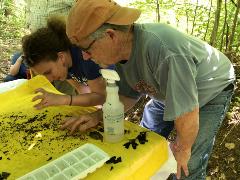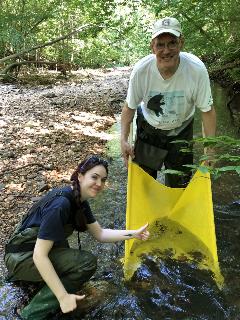A New Challenge
I had just returned from a long day with our youth at the League’s 2016 national convention in Stevens Point, Wisconsin. My shoes (and the rest of me) were caked with mud after exploring a stream with 25 kids from across the country. I was covered in sunscreen and mosquito bites and ready for a hot shower and bed! Yet as I made my way through the hotel lobby, I heard someone call my name.
“Hey, Sam! Did you hear about the Clean Water Challenge?” It was none other than Scott Kovarovics, executive director of the Izaak Walton League. “We’re going to monitor 100,000 stream sites by the League’s 100th anniversary in 2022. Our members came up with it.”
“That sounds great!” I replied.
Then Scott asked a question that stopped me in my tracks: “So how many monitoring sites do we have now?”
I had no idea.
There was no comprehensive list of stream monitoring sites (or even active stream monitors) across the country – not just for the League but for any volunteer group.
Beyond just the monitoring site location is the information volunteers collect, from water temperature to macroinvertebrate counts. We would need to gather all of that information to count a stream site as part of our Clean Water Challenge goal. I thought about the thousands of volunteers trained through Save Our Streams (SOS) – the League program that helps volunteers collect information on stream health. I realized we had no idea whether people were still monitoring local streams and, if so, what they were doing with their water quality data.
It became clear that if we were going to have volunteers monitor 100,000 stream sites – and not just collect data but help people use that data to improve water quality where they live – we would need an efficient and user-friendly way to gather and share water quality information.
First we needed to understand what had (and had not) worked in the past.
Understanding Volunteer Needs
Over several months, we explored the vast legacy of Save Our Streams. I put on my Sherlock Holmes cap and uncovered data, training histories, and other breadcrumbs left by past Clean Water Program staff.
A few volunteers had put their stream monitoring results into our Creek Freaks database (later rebranded under Save Our Streams), so we had that as a starting point. However, most of our volunteers never used the database, and many who did only used it once. This suggested barriers that we would need to overcome to help volunteers track and share water quality test results.
We also knew that stream monitors want to do more with their data than simply collect it. They want to get their findings to the local, state, and federal agencies charged with protecting clean water. Not only that, volunteers want to share their stream monitoring results with their own communities – to talk about water quality in a compelling way.
We looked to our Virginia Save Our Streams (VASOS) program for inspiration. Stream monitors in Virginia put the water quality information they collect into a database managed by League staff and a volunteer database developer. The data is quality checked by League staff and submitted to the Virginia Department of Environmental Quality (DEQ), which uses the data in its water quality reports to the Environmental Protection Agency. DEQ also uses volunteer-collected data to track the effectiveness of stream restoration efforts, identify waterways in need of more intensive monitoring by DEQ staff, and educate landowners about land uses that can cause water quality problems. The fact that volunteer-collected data is actively being used to improve water quality across Virginia is a large part of our success in engaging volunteers on the ground and having them submit monitoring results.
To achieve similar results at the national level, we needed a national database to collect and manage stream monitoring results – and to make those results accessible to everyone concerned about water quality.
Building a Clean Water Hub
Building a national database of stream monitoring results would require a developer with not only web experience but an understanding of water quality monitoring and how we work with our volunteers. Fortunately, we crossed paths with John Dawes, executive director of The Commons (formerly Chesapeake Commons).
John has a wealth of experience in the water quality monitoring field. In fact, his organization’s vision statement is “better data, better decisions, for a clean environment and healthier people.” This couples perfectly with the goal of the Clean Water Challenge and the needs of the League’s Clean Water Program. Our connection with John and his team was just what we needed to build the ultimate volunteer water quality monitoring database.
But we wanted more than a place to store data. We wanted to make data accessible to people in communities across the country – and help them use that information to improve water quality where they live. John’s innovative data visualization approach is what truly makes him and The Commons unique. “One of the things we enjoy most is translating complex data collections into visual information that can be easily understood,” he says. “Clean, intuitive maps and diagrams reveal patterns and lead to smarter [water quality] problem-solving.”
With funding from the Pisces Foundation, the Izaak Walton League and The Commons are also working to unify volunteer stream monitoring results on a single web platform. In fact, our goal is to build a Clean Water Hub capable of accepting and displaying results from many different types of water quality tests from many organizations. So no matter which volunteers are monitoring a stream, the results will be accessible to people in communities nationwide as well as to other volunteers and local, state, and federal agencies.

Where We Are Now
After months of building, beta testing, and bug fixing, the Clean Water Hub is now LIVE.
For the first time, Save Our Streams volunteers have a place to store and track their data that is simple to use and easy to access. Even more exciting, every American can now access up-to-date water quality information where they live – real-time data collected by local volunteers. The data our volunteers work so hard to collect is finally accessible! Visit cleanwaterhub.org and click “Explore the Map” to find water quality results near you.
The moment stream monitors complete a session in the field, they can upload their biological (macroinvertebrate) and chemical test results to the Hub – not just Save Our Streams data but also data collected through the Virginia Save Our Streams and Chesapeake Monitoring Cooperative programs (which use slightly different protocols than the national Save Our Streams program). If monitors find a water quality problem, they can encourage landowners and community members to participate in clean-up events or conservation activities to help improve stream health.
We are also connecting the Hub to the federal Water Quality Exchange (WQX), a data system that federal, state, and local agencies use to manage their own water quality data and consider data collected by other organizations. Making data from the Hub available in WQX (with all the proper quality assurance documentation) will ensure volunteer-collected data is considered as part of the water quality reporting, protection, and restoration done by agencies across the country – another hurdle the Hub is helping stream monitors overcome.
Our next goal is to turn the Hub into just that – a “hub” for different water quality results across the country, from streamside results to lab-analyzed data, to give communities a clearer, more consistent picture of local water quality.
Where We Are Going – Together

The goal of our Clean Water Challenge is not just to collect data on stream health but to use that data to improve and protect water quality in communities across the country. You don’t need to be a stream monitor to effect change – you just need a story to tell. And the Clean Water Hub will help you do that.
Visit the Hub website at cleanwaterhub.org and click “Explore the Map” to see stream monitoring sites across the country. Zoom in on the map and click a dot to find details on a stream monitoring site near you. Click the blue arrow to get to the monitoring results, which are color coded to show exactly how your stream rates based on Save Our Streams protocols: Excellent (green), Good (yellow), Fair (orange), or Poor (red).
As stream monitors continue to add data to the Hub, you will see trends in water quality that you can use to advocate for local action to protect, improve, and restore water quality. Is your favorite trout stream low in dissolved oxygen? Are the macroinvertebrate populations poor? Does the creek feeding your town’s drinking water supplies have spikes in chloride or nitrates? Use this data to raise local awareness of water quality issues – and demand action!

Talk to local and state agencies charged with protecting water quality and flag problem areas for them to investigate. Look for opportunities to prevent water pollution, whether it’s installing plants stream-side to filter runoff or sharing best practices for winter road salt application with town managers. The information in our Clean Water Hub provides clear evidence on stream health that you can use to educate your community.
Working with John and the folks at The Commons, we will be developing ways to visualize data from other stream monitoring protocols to further expand public access to up-to-date water quality information.
When I spoke with John about our goals for this effort, he said, “We are here to change the game for the volunteer water monitoring field in terms of technology and public availability of data. This is cool stuff, Sam. Really cool stuff.”
I couldn’t have said it better myself.
Help us do more of this work